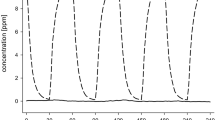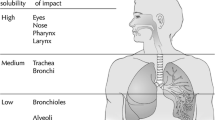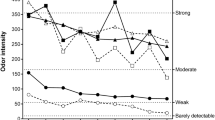Abstract
Human data about the potency of ethyl acrylate to evoke sensory irritation is currently not available. Therefore, we conducted an experimental exposure study and the magnitude of chemosensory effects in healthy human volunteers was mathematically modeled by combining the factors current concentration (c) and duration/time (t). In a repeated-measures design, 19 subjects were exposed for 4 h to constant and varying concentrations (including peaks of 5 and 10 ppm) of ethyl acrylate with either a 2.5 or 5 ppm time-weighted average (TWA) concentration. Clean air served as control condition. Nasal lavage fluid, eye blinking frequencies, and rhinomanometry were used as physiological measures of sensory irritation. Several subjective ratings assessed olfactory and trigeminal perceptions. The blinking frequency was significantly increased during the varying 5 ppm condition. Regardless of the TWA concentration, varying exposures caused stronger effects than constant exposures. Our mathematical modeling showed that olfactory perceptions generally decreased over time while ratings of eye irritation increased over time even under the constant 5 ppm condition. Including the current concentration in the mathematical modeling always increased the goodness of fit substantially. The results showed that the intensity of sensory irritation could be predicted best with a complex c × t model. During the 2.5 ppm conditions, only the current concentration predicted the ratings and time-dependent processes could not be observed. However, in both 5 ppm TWA conditions strong eye irritations and increased blinking frequency, only at the end of the 4-h exposures a dose-dependency of these adverse effects was clearly shown.






Similar content being viewed by others
References
Abraham MH, Gola JM, Cometto-Muniz JE (2015) An assessment of air quality reflecting the chemosensory irritation impact of mixtures of volatile organic compounds. Environ Int 86:84–91. doi:10.1016/j.envint.2015.07.012
Brüning T, Bartsch R, Bolt HM et al (2014) Sensory irritation as a basis for setting occupational exposure limits. Arch Toxicol 88(10):1855–1879. doi:10.1007/s00204-014-1346-z
DFG (2014) List of MAK and BAT values. WILEY-VCH verlag GmbH, Weinheim
Dick RB, Ahlers H (1998) Chemicals in the workplace: incorporating human neurobehavioral testing into the regulatory process. Am J Ind Med 33(5):439–453. doi:10.1002/(SICI)1097-0274(199805)
Ding X, Dahl AR (2003) Olfactory mucosa: composition, enzymatic localization, and metabolism. In: Doty RL (ed) Handbook of olfaction and gustation. Marcek Dekker, New York, pp 51–73
Green BG, Dalton P, Cowart B, Shaffer G, Rankin K, Higgins J (1996) Evaluating the ‘labeled magnitude scale’ for measuring sensations of taste and smell. Chem Senses 21(3):323–334. doi:10.1093/chemse/21.3.313
Harkema JR, Wagner JG, Carey SA (2016) Comparative anatomy of nasal airways: relevance to inhalation toxicology and human health. In: Morris JB, Shusterman DJ (eds) Toxicology of the nose and upper airways. Informa Healthcare, New York, pp 1–17
Hey K, Juran S, Schäper M et al (2009) Neurobehavioral effects during exposures to propionic acid-an indicator of chemosensory distraction? Neurotoxicology 30(6):1223–1232. doi:10.1016/j.neuro.2009.08.009
Hummel T, Sekinger B, Wolf SR, Pauli E, Kobal G (1997) ‘Sniffin’ sticks’: olfactory performance assessed by the combined testing of odor identification, odor discrimination and olfactory threshold. Chem Senses 22(1):39–52. doi:10.1093/chemse/22.1.39
Hunter DD, Satterfield BE, Huang J, Fedan JS, Dey RD (2000) Toluene diisocyanate enhances substance P in sensory neurons innervating the nasal mucosa. Am J Respir Crit Care Med 161(2):543-549. doi:10.1164/ajrccm.161.2.9812083
Juran SA, van Thriel C, Kleinbeck S et al (2012) Neurobehavioral performance in human volunteers during inhalation exposure to the unpleasant local irritant cyclohexylamine. Neurotoxicology 33(5):1180–1187. doi:10.1016/j.neuro.2012.06.014
Kiesswetter E, van Thriel C, Schäper M, Blaszkewicz M, Seeber A (2005) Eye blinks as indicator for sensory irritation during constant and peak exposures to 2-ethylhexanol. Environm Toxicol Pharmacol 19:531–541. doi:10.1016/j.etap.2004.12.056
Kleinbeck S, Juran SA, Kiesswetter E et al (2008) Evaluation of ethyl acetate on three dimensions: Investigation of behavioral, physiological and psychological indicators of adverse chemosensory effects. Toxicol Lett 182(1–3):102–109. doi:10.1016/j.toxlet.2008.09.001
Kobal G, Van Toller S, Hummel T (1989) Is there directional smelling? Experientia 45(2):130–132. doi:10.1007/BF01954845
Koskela H, Di Sciascio MB, Anderson SD et al (2000) Nasal hyperosmolar challenge with a dry powder of mannitol in patients with allergic rhinitis. Evidence for epithelial cell involvement. Clin Exp Allergy 30(11):1627–1636. doi:10.1046/j.1365-2222.2000.00923.x
Miller RR, Young JT, Kociba RJ et al (1985) Chronic toxicity and oncogenicity bioassay of inhaled ethyl acrylate in Fischer 344 rats and B6C3F1 mice. Drug Chem Toxicol 8(1–2):1–42. doi:10.3109/01480548509011632
Nemec JW, Bauer W (1978) Acrylic acid and derivatives. Kirk-Othmer Encycl Chemical Technol 1:330–354
Parasuraman R, Warm JS, See JE (2000) Brain systems of vigilance. In: Parasuraman R (ed) The attentive brain. MIT Press, Cambridge (MA), pp 221–256
Schultz KD, Furkert J, O’Connor A et al (1996) Determination of substance P in human nasal lavage fluid. Neuropeptides 30(2):117–124. doi:10.1016/S0143-4179(96)90078-5
Shusterman D, Matovinovic E, Salmon A (2006) Does Haber’s law apply to human sensory irritation? Inhal Toxicol 18(7):457–471. doi:10.1080/08958370600602322
van Thriel C, Haumann K, Kiesswetter E, Blaszkewicz M, Seeber A (2002) Time courses of sensory irritations due to 2-butanone and ethyl benzene exposure: influences of self-reported multiple chemical sensitivity (sMCS). Int J Hyg Environ Health 204(5–6):367–369. doi:10.1078/1438-4639-00112
van Thriel C, Seeber A, Kiesswetter E, Blaszkewicz M, Golka K, Wiesmüller GA (2003) Physiological and psychological approaches to chemosensory effects of solvents. Toxicol Lett 140–141:261–271. doi:10.1016/S0378-4274(03)00022-5
van Thriel C, Kiesswetter E, Schäper M, Blaszkewicz M, Golka K, Seeber A (2005) An integrative approach considering acute symptoms and intensity ratings of chemosensory sensations during experimental exposures. Environ Toxicol Pharmacol 19:589–598. doi:10.1016/j.etap.2004.12.024
van Thriel C, Schäper M, Kiesswetter E et al (2006) From chemosensory thresholds to whole body exposures-experimental approaches evaluating chemosensory effects of chemicals. Int Arch Occup Environ Health 79(4):308–321. doi:10.1007/s00420-005-0057-4
van Thriel C, Blaszkewicz M, Schäper M et al (2007) Chemosensory effects during acute exposure to N-methyl-2-pyrrolidone (NMP). Toxicol Lett 175(1–3):44–56. doi:10.1016/j.toxlet.2007.09.007
van Thriel C, Schäper M, Kleinbeck S et al (2010) Sensory and pulmonary effects of acute exposure to sulfur dioxide (SO(2)). Toxicol Lett 16:42–50. doi:10.1016/j.toxlet.2010.03.013
Winneke G (1992) Structure and determinants of psychophysiological response to odorant/irritant air pollution. Ann N Y Acad Sci 641:261–276. doi:10.1111/j.1749-6632.1992.tb16548.x
Wise PM, Canty TM, Wysocki CJ (2005) Temporal integration of nasal irritation from ammonia at threshold and supra-threshold levels. Toxicol Sci 87(1):223–231. doi:10.1093/toxsci/kfi229
Wise PM, Canty TM, Wysocki CJ (2006) Temporal Integration in Nasal Lateralization of Ethanol. Chem Senses 31(3):227–235. doi:10.1093/chemse/bjj023
Wise PM, Zhao K, Wysocki CJ (2010) Dynamics of nasal irritation from pulsed homologous alcohols. Chem Senses 35(9):823–829. doi:10.1093/chemse/bjq086
Wolkoff P (2016) External eye symptoms in indoor environments. Indoor Air. doi:10.1111/ina.12322
Wolkoff P, Skov P, Franck C, Petersen LN (2003) Eye irritation and environmental factors in the office environment–hypotheses, causes and a physiological model. Scand J Work Environ Health 29(6):411–430. doi:10.5271/sjweh.748
Wolkoff P, Karcher T, Mayer H (2012) Problems of the “outer eyes” in the office environment: an ergophthalmologic approach. J Occup Environ Med 54(5):621–631. doi:10.1097/JOM.0b013e31824d2e04
Acknowledgements
The authors would like to thank all participants as well as the staff of the involved working groups for conducting the experiment and the extensive chemical analyses. The study was funded by the Deutsche Gesetzliche Unfallversicherung (DGUV).
Author information
Authors and Affiliations
Corresponding author
Ethics declarations
Conflict of interest
None.
Rights and permissions
About this article
Cite this article
Kleinbeck, S., Schäper, M., Zimmermann, A. et al. Prediction of human sensory irritation due to ethyl acrylate: the appropriateness of time-weighted average concentration × time models for varying concentrations. Arch Toxicol 91, 3051–3064 (2017). https://doi.org/10.1007/s00204-017-1934-9
Received:
Accepted:
Published:
Issue Date:
DOI: https://doi.org/10.1007/s00204-017-1934-9




